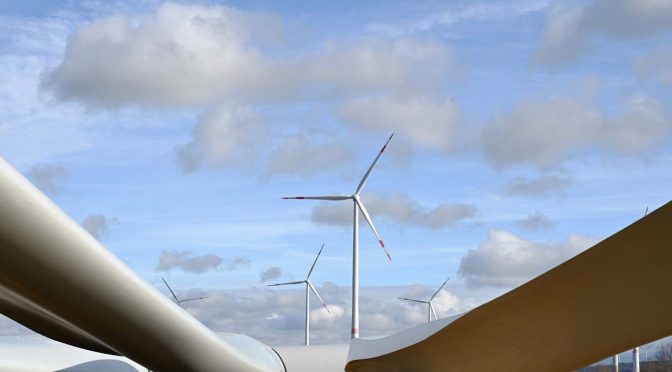
Seven of RWE’s existing wind turbines in Eemshaven (Westereems wind farm) will get black blades.
In addition to the effect on birds, the effect on the landscape and the effect on aviation safety as well as the technical effect on the blades are to be examined.
RWE is part of the Dutch “Black Blade” study. Seven of RWE’s wind turbines in Eemshaven are each getting one black blade and two white ones. One of the aims of this study is to find out whether painting a wind turbine blade black helps birds to fly more safely between the turbines. The study is based on the assumption that the black rotor blade provides increased contrast and thus increased visibility of the rotors. This would make it easier for the birds to detect the wind turbines and avoid them. The effect on the birds will be monitored for two years. The Dutch Black Blade Study goes beyond the results of the previous study in Norway: In addition to the effect on local birds, the study examines flight safety, the effect of the black painted blades on the landscape, and the painted blades themselves. This study fits perfectly with RWE’s sustainability strategy of innovations for operating its sites in harmony with the ecosystem.
RWE and the Province of Groningen started the research in 2021, in collaboration with the Dutch government (Ministries of EZK and RWS, Provinces of Flevoland, Gelderland, Overijssel, Limburg, South Holland and North Brabant), the nature sector (bird protection) and private parties in the wind sector (Vattenfall, Eneco Energy, Pure Energy, Statkraft Energy and Groningen.nl Energy). The research will continue until 2024.
Effect of black blades on birds
The ecological part of the research started in September 2021 with a baseline measurement. Researchers from two independent research bureaus checked how many birds flew into fourteen wind turbines each week. RWE’s wind farm in Eemshaven lends itself well to this research, due to the high number of birds in this area. It is a crossing point for migratory birds in spring and autumn, and the area has a wide range of bird species. Seabirds such as gulls and terns fly here, as well as land birds such as blackbirds and starlings, and birds of prey such as buzzards and kestrels. An important question in this research is therefore the efficacy of the black painted blades for different types of birds.
Technical effect of black paint on wind turbine blades
The painting of the blades started in August and was regularly halted due to weather conditions. Painting the blades is an intensive and time-consuming process. First, the turbine has to be shut down, the suspension bridge installation (in which the painters stand) has to be installed, and then the blades have to be sanded, degreased and painted twice. The painting process takes about three to four days per turbine.
Once the paint is on, it is necessary to find out what effect this has on the blade material. Black paint attracts heat, causing the temperature of the blade to rise and possibly overheat on hot, sunny days. With thermometers installed inside the blades and additional inspections, the impact on the material will be monitored. The impact on preventive maintenance and performance of the turbines will also be checked.
In addition to the technical effect, the study also looks at the impact on the landscape . The question here is how people view a turbine when one of its blades is colored black. Pilots who regularly fly over the area are also being consulted about their experiences in the context of aviation safety.
“As a major player in the global energy market, we are aware of the responsibility that comes with our role. For RWE, this means that we take socially relevant issues into account in our business decisions, that we also consider the consequences of our actions outside our formal area of responsibility, and that we view our business activities not only from a business perspective, but also from an ecological, social and ethical standpoint. Strict environmental legislation and licensing requirements set the framework for our operational activities in the regions where we operate. Some of our activities go beyond the obligations set out in laws and permits and this study is a good example of that.”